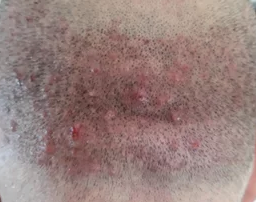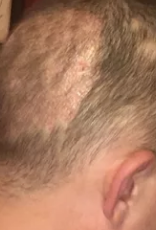You can use topical minoxidil even if you are treating your high blood pressure with other medications.
A biopsy rules out specific autoimmune diseases in women that causes hair loss but the diagnosis of FPHL is not helpful.
The first step in evaluating hair loss in women, after a detailed history and physical exam, is to rule out any underlying medical causes of hair loss which can be treated. If clinically appropriate, the following disease processes should be considered: anemia, thyroid disease, connective tissue disease, gynecological conditions and emotional stress. Furthermore, over 50% of women going through a change of life hormone fluctuations (menopause) experience significant hair loss. It is also important to review the use of medications that may cause hair loss, such as (but not limited to) oral contraceptives, beta-blockers, Vitamin A, thyroid drugs, coumadin, and prednisone. The following laboratory tests have been recommended to rule out the aforementioned medical conditions.
Some common blood tests for female hair loss:
- Sex Hormone tests
- SHBG (Sex Hormone Binding Globulin) used to test status of male hormones
- Estradiol is a sex hormone
- FSH (Follicle Stimulating Hormone) *not hair follicle but follicle in the ovary*
- LH (Luteinizing Hormone) is a sex hormone
- Free Testosterone
- Total Testosterone
- ANA (Anti Nuclear Antibody) used to test for Lupus or other autoimmune diseases
- TSH (Thyroid Stimulating Hormone) used to test for hyper or hypo-thyroid disease
- Test Iron status
- TIBC (Total Iron Binding Capacity)
- Ferritin
- Iron
This patient supplied photos. I would want to know more about the tests that I listed above before going forward with any recommendations as problems with some of these tests will not show up on biopsy.
The concept is simple enough. The normal scalp is stretched slowly over weeks with a balloon placed under the healthy part of the scalp. The balloon is then inflated three times a week until enough stretch is achieved to be able to advance the normal hair to cover the scarred area, which is removed on the same surgical procedure. It is not as painful as it looks. I have had patients wear a soft hat and they disguised the entire distortion. The scarring on this man most likely came from either an accident or a burn (if the photo does not show, click on the Icon).
A headache could be a sign of reduced blood pressure from the Rogaine (minoxidil), so I recommend speaking with your doctor and to get your blood pressure checked out. Minoxidil was originally developed as a treatment for high blood pressure, so if you have normal blood pressure and the blood pressure becomes low while on the drug, then you can get headaches as the first symptom of the medication.
I have a problem with finasteride. My face is a lot fatter since I started taking finasteride and I feel like it makes me more feminine.
So there is 2 reason for that:
- I’m getting fatter.
- Finasteride changed my hormone ratio, something like a lot of the testosterone that finasteride gave me is converted to estrogen.
If the problem is the estrogen, do you think it’s normal that my libido and erection are still working very well?
I don’t think that your analysis is correct. Maybe there are other causes for your weight gain. With a good libido and a strong erection, the drug is clearly not impacting your sexuality.
If you rubbed too hard on the crusts in the recipient area prior to the 12th day, you could have dislodged grafts. I wrote an article on this, and it takes 12 days for the grafts to be secure with crusting. (Read here: https://baldingblog.com/wp-content/uploads/pdf/mp-2006-graft-anchoring.pdf).
Other than finasteride, which seems like you are taking, there is nothing else to do if you achieved your goals. The nice thing about hair transplants is that they are permanent just like your normal hair. If you lose more hair, or didn’t get the full benefits from what you had done now, then another hair transplant may be reasonable. However, if your donor density limits were exceeded for FUE, then a strip surgery alternative may be the best option, if you need more hair transplants.
You should get a HAIRCHECK test to find out if there is any loss that you can’t see in the top and crown area of your head. You need to know there is the possibility that you might develop hair loss elsewhere. I call this a Master Plan which every male having a hair transplant should have. You look, on the surface, to be a great candidate, but if the HAIRCHECK test reveals hair loss behind the hairline, it is something you MUST know (See: https://baldingblog.com/value-haircheck-bulk-measurements-two-patients-seen-today/)
That is the $64,000 question. No one knows for sure, but I personally think that it should not ruin your chances in participating in the cure when it is out.
Some doctors had lawsuits when someone claimed that they lost their sex drive permanently. The risk is far less than 1:1000 but some doctors put their fears in front of patient’s welfare. What I do is inform my patients of all of the risks then prescribe it. It is the patient’s decision to take or not to take the drug. My son took finasteride for 15 years so far, and he told me that his sex drive went up when he went on the medications. I take it with no problems. Of course, internet forums only want the bad news, so you rarely hear about the other side effects. Any doctor can prescribe it, even your family doctor.
There is no evidence that mesotherapy works from what I have read. You should make sure that this treatment can be validated by your doctor. Finasteride is a known entity and the sexual side effects that your doctor is discussing is between 2-4%. The decision is yours, of course.
Page 306 of 635





